Predicting Potential Habitat Changes of Two Invasive Alien Fish Species with Climate Change at a Regional Scale
Abstract
:1. Introduction
2. Materials and Methods
2.1. Study Region and Observations of the Invasive Alien Fish Species
2.2. Species Distribution Models
2.3. Input Data for SDMs
3. Results
3.1. Simulated Current Status of the Habitat Distribution of the Invasive Alien Species
3.2. Future Simulations of Habitat Distributions of the Invasive Alien Species
4. Discussion and Conclusions
Author Contributions
Funding
Institutional Review Board Statement
Informed Consent Statement
Data Availability Statement
Conflicts of Interest
Appendix A
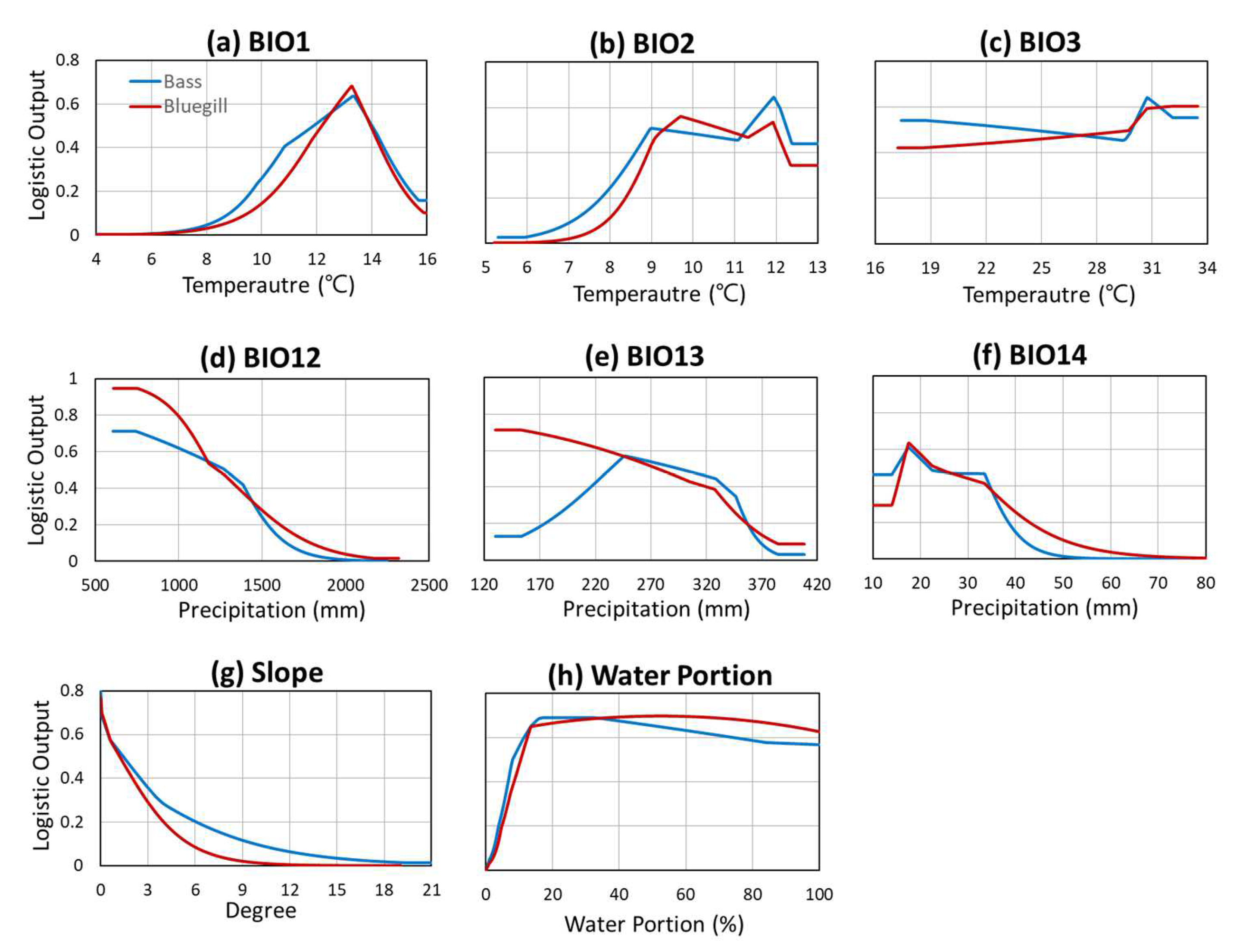
References
- Early, R.; Bradley, B.A.; Dukes, J.S.; Lawler, J.J.; Olden, J.D.; Blumenthal, D.M.; Gonzales, P.; Grosholz, E.D.; Ibañez, I.; Miller, L.P.; et al. Global threats from invasive alien species in the twenty-first century and national response capacities. Nat. Commun. 2016, 7, 12485. [Google Scholar] [CrossRef] [PubMed]
- Bellard, C.; Rysman, J.F.; Leroy, B.; Claud, C.; Mace, G.M. A global picture of biological invasion threat on islands. Nat. Ecol. Evol. 2017, 1, 1862–1869. [Google Scholar] [CrossRef] [PubMed]
- Gallardo, B.; Bacher, S.; Bradley, B.; Comín, F.A.; Gallien, L.; Jeschke, J.M.; Sorte, C.J.B.; Vilà, M. InvasiBES: Understanding and managing the impacts of Invasive alien species on Biodiversity and Ecosystem Services. NeoBiota 2019, 50, 109–122. [Google Scholar] [CrossRef]
- Essl, F.; Lenzner, B.; Bacher, S.; Bailey, S.; Capinha, C.; Daehler, C.; Dullinger, S.; Genovesi, P.; Hui, C.; Hulme, P.E.; et al. Drivers of future alien species impacts: An expert-based assessment. Glob. Chang. Biol. 2020, 26, 4880–4893. [Google Scholar] [CrossRef] [PubMed]
- Mun, S.; Nam, K.-H.; Kim, C.-G.; Chun, Y.J.; Lee, H.-W.; Kil, J.H.; Lee, J.C. Suggestions for the improvement of the invasive alien species management in Korea—A comparative analysis of the legal framework for invasive alien species between Japan and Korea. J. Environ. Policy Adm. 2013, 21, 35–54. [Google Scholar] [CrossRef]
- Essl, F.; Nehring, S.; Klingenstein, F.; Milasowszky, N.; Nowack, C.; Rabitsch, W. Review of risk assessment systems of IAS in Europe and introducing the German-Austrian Black List Information System (GABLIS). J. Nat. Conserv. 2011, 19, 339–350. [Google Scholar] [CrossRef]
- Branquart, E. Guidelines for Environmental Impact Assessment and List Classification of Nonnative Organisms in Belgium; Version 2.6; Belgian Biodiversity Platform: Brussels, Belgium, 2009. [Google Scholar]
- Weaver, R.O.; Ziebell, C.D. Ecology and early life history of largemouth bass and bluegill in imperial reservoir, Arizona. Southwest Nat. 1976, 21, 151–160. [Google Scholar] [CrossRef]
- Zhang, M. Population Biology of Largemouth Bass, Micropterus salmoides in Goe-San Lake, South Korea. Ph.D. Thesis, Pukyoung National University, Busan, Korea, 2013; 126p. [Google Scholar]
- Mamun, Md.; Kim, S.; An, K.-G. Distribution pattern prediction of an invasive alien species largemouth bass using a maximum entropy model (MaxEnt) in the Korea peninsula. J. Asia-Pac. Biodivers. 2018, 11, 516–524. [Google Scholar] [CrossRef]
- Hong, Y.P.; Son, Y.M. Studies on the interspecific association of community including Micropterus salmoides population, Introduced fish in Korea. Korean J. Ichthyol. 2003, 15, 61–68. [Google Scholar]
- Maezono, Y.; Miyashita, T. Community-level impacts induced by introduced largemouth bass and bluegill in farm ponds in Japan. Biol. Conserv. 2003, 109, 111–121. [Google Scholar] [CrossRef]
- Ko, M.H.; Park, J.Y.; Lee, Y.J. Feeding habits of an introduced large mouth bass, Micropterus salmoides (Perciformes; Centrachidae), and its influence on ichthyofauna in the Lake Okjeong. Korean J. Ichthyol. 2008, 20, 36–44. [Google Scholar]
- Kang, J.-G.; Kim, J.-T. Analysis on the Bluegill blocking effects using bubbles. J. Korea Acad.-Ind. Coop. Soc. 2017, 18, 390–397. [Google Scholar] [CrossRef]
- Austin, M.P.; Van Niel, K.P. Improving species distribution models for climate change studies: Variable selection and scale. J. Biogeogr. 2011, 38, 1–8. [Google Scholar] [CrossRef]
- Stanton, C.J.; Pearson, G.R.; Horning, N.; Ersts, P.; Akçakaya, H.R. Combining static and dynamic variables in species distribution models under climate change. Methods Ecol. Evol. 2012, 3, 349–357. [Google Scholar] [CrossRef]
- Porfirio, L.L.; Harris, M.B.R.; Lefroy, C.E.; Hugh, S.; Gould, F.S.; Lee, G.; Bindoff, L.N.; Mackey, B. Improving the use of species distribution models in conservation planning and management under climate change. PLoS ONE 2014, 9, e113749. [Google Scholar] [CrossRef] [Green Version]
- Guillera-Arroita, G.; Lahoz-Monfort, J.J.; Elith, J.; Gordon, A.; Kujala, H.; Lentini, E.P.; McCarthy, A.M.; Tingley, R.; Wintle, A.B. Is my species distribution model fit for purpose? Matching data and models to applications. Glob. Ecol. Biogeogr. 2015, 24, 276–292. [Google Scholar] [CrossRef]
- Forester, R.F.; DeChaine, E.G.; Bunn, A.G. Integrating ensemble species distribution modelling and statistical phylogeography to inform projections of climate impacts on species distributions. Divers. Distrib. 2013, 19, 1480–1495. [Google Scholar] [CrossRef]
- Lozier, D.J.; Mills, J.N. Predicting the potential invasive range of light brown apple moth (Epiphyas postvittana) using biologically informed and correlative species distribution models. Biol. Invasions 2011, 13, 2409–2421. [Google Scholar] [CrossRef]
- Srivastava, V.; Lafond, V.; Griess, V.C. Species distribution models (SDM): Applications, benefits and challenges in invasive species management. CAB Rev. 2019, 14, 1–13. [Google Scholar] [CrossRef]
- Runquist, B.R.D.; Lake, T.; Tiffin, P.; Moeller, A.D. Species distribution models throughout the invasion history of Palmer amaranth predict regions at risk of future invasion and reveal challenges with modelling rapidly shifting geographic ranges. Sci. Rep. 2019, 9, 2426. [Google Scholar] [CrossRef] [Green Version]
- Bae, E.; Jung, J. Prediction of shift in fish distributions in the Geum River Watershed under climate change. Ecol. Resilient Infrastruct. 2015, 2, 198–205. [Google Scholar] [CrossRef] [Green Version]
- Jeong, S.G.; Lee, D.K.; Ryu, J.E. Riparian connectivity assessment using species distribution model of fish assembly. J. Korean Soc. Geospat. Inf. Sci. 2015, 23, 17–26. [Google Scholar] [CrossRef]
- Kärcher, O.; Frank, K.; Walz, A.; Markovic, D. Scale effects on the performance of niche-based models of freshwater fish distributions. Ecol. Model. 2019, 405, 33–42. [Google Scholar] [CrossRef]
- Kim, Z.; Shim, T.; Koo, Y.-M.; Seo, D.; Kim, Y.-O.; Hwang, S.-J.; Jung, J. Predicting the impact of climate change on freshwater fish distribution by incorporating water flow rate and quality variables. Sustainability 2020, 12, 10001. [Google Scholar] [CrossRef]
- Hofmann, M.; Voloscuik, C.; Dubrovsky, M.; Maraun, D.; Schultz, H.R. Downscaling of climate scenarios for a high resolution, site-specific assessment of drought stress risk for two viticultural regions with heterogeneous landscapes. Earth Syst. Dyn. Discuss. 2021, 1–26. [Google Scholar] [CrossRef]
- Navarro-Racines, C.; Tarapues, J.; Thornton, P.; Jarvis, A.; Ramirez-Villegas, J. High-resolution and bias-corrected CMIP5 projections for climate change impact assessments. Sci. Data 2020, 7, 7. [Google Scholar] [CrossRef] [PubMed] [Green Version]
- Thuiller, W.; Lafourcade, B.; Araújo, M.B. BIOMOD—A platform for ensemble forecasting of species distributions. Ecography 2009, 32, 369–373. [Google Scholar] [CrossRef]
- Allouche, O.; Tsoar, A.; Kadmon, R. Assessing the accuracy of species distribution models: Prevalence, kappa and the true skill statistic (TSS). J. Appl. Ecol. 2006, 43, 1223–1232. [Google Scholar] [CrossRef]
- Koo, K.A.; Park, S.U.; Kong, W.S.; Hong, S.; Jang, I.; Seo, C. Potential climate change effects on tree distributions in the Korean Peninsula: Understanding model & climate uncertainties. Ecol. Model. 2017, 353, 17–27. [Google Scholar] [CrossRef]
- Hijmans, J.R.; Phillips, S.; Leathwick, J.; Elith, J. Species Distribution Modelling. R Package Version 1.1.4. 2017. Available online: https://CRAN.R-project.org/package=dismo (accessed on 1 November 2020).
- Koo, K.A.; Kong, W.S.; Nibbelink, N.P.; Hopkinson, C.S.; Lee, J.H. Potential effects of climate change on the distribution of cold-tolerant evergreen broadleaved woody plants in the Korean Peninsula. PLoS ONE 2015, 10, e0134043. [Google Scholar] [CrossRef]
- Park, S.U.; Koo, K.A.; Seo, C.; Hong, S. Climate-related range shifts of Ardisia japonica in the Korean Peninsula: A role of dispersal capacity. J. Ecol. Environ. 2017, 41, 38. [Google Scholar] [CrossRef] [Green Version]
- Koo, K.A.; Park, S.U.; Hong, S.; Jang, I.; Seo, C. Future distributions of warm-adapted evergreen trees, Neolitsea sericea and Camellia japonica under climate change: Ensemble forecasts and predictive uncertainty. Ecol. Res. 2018, 33, 313–325. [Google Scholar] [CrossRef]
- Moss, H.R.; Babiker, M.; Brinkman, S.; Calvo, E.; Carter, T.; Edmonds, J.A.; Elgizouli, I.; Emori, S.; Lin, E.; Hibbard, K.; et al. Towards New Scenarios for Analysis of Emissions, Climate Change, Impacts, and Response Strategies; Intergovernmental Panel on Climate Change: Geneva, Switzerland, 2008. [Google Scholar]
- Kim, M.K.; Kim, S.; Kim, J.; Heo, J.; Park, J.S.; Kwon, W.T.; Suh, M.S. Statistical downscaling for daily precipitation in Korea using combined PRISM, RCM, and quantile mapping: Part 1. Methodology and evaluation in historical simulation. Asia-Pac. J. Atmos. Sci. 2012, 52, 79–89. [Google Scholar] [CrossRef]
- Kim, M.K.; Lee, D.H.; Kim, J. Production and Validation of Daily Grid Data with 1 km Resolution in South Korea. J. Clim. Res. 2013, 8, 13–25. [Google Scholar]
- Hansen, G.J.A.; Read, J.S.; Hansen, J.F.; Winslow, L.A. Projected shifts in fish species dominance in Wisconsin lakes under climate change. Glob. Chang. Biol. 2017, 23, 1463–1476. [Google Scholar] [CrossRef] [PubMed]
- Troia, M.J.; Giam, X. Extreme heat events and the vulnerability of endemic montane fishes to climate change. Ecography 2019, 42, 1913–1925. [Google Scholar] [CrossRef] [Green Version]
- Kim, Z.; Shim, T.; Ki, S.J.; An, K.-G.; Jung, J. Prediction of three-dimensional shift in the distribution of largemouth bass (Micropterus salmoides) under climate change in South Korea. Eco. Indic. 2022, 137, 108731. [Google Scholar] [CrossRef]
- Moon, W.K.; Han, J.H.; An, K.G. Fish fauna and community analysis on Heuck Stream Watershed. Korean J. Limnol. 2010, 43, 69–81. [Google Scholar]
- Isaak, D.J.; Young, M.K.; Luce, C.H.; Hostetler, S.W.; Wenger, S.J.; Peterson, E.E.; Nagel, D.E. Slow climate velocities of mountain streams portend their role as refugia for cold-water biodiversity. Proc. Natl. Acad. Sci. USA 2016, 113, 4374–4379. [Google Scholar] [CrossRef] [Green Version]
- Yoon, J.-D.; Kim, J.-H.; Park, S.-H.; Jang, M.-H. The Distribution and Diversity of Freshwater Fishes in Korean Peninsula. Korean J. Ecol. Environ. 2018, 51, 71–85. [Google Scholar] [CrossRef]
- Walter, A.W.; Mandeville, C.P.; Rahel, F.J. The interaction of exposure and warming determines fish species vulnerability to warming stream temperature. Biol. Lett. 2018, 14, 2018032. [Google Scholar] [CrossRef] [Green Version]
- Ruiz-Naavarro, A.; Gillingham, P.K.; Britton, J.R. Predicting shifts in the climate space of freshwater in Great Britain due to climate change. Biol. Conserv. 2016, 203, 33–42. [Google Scholar] [CrossRef]
- Sharma, A.; Dubey, V.K.; Johnson, J.A.; Rawal, Y.K.; Sivakumar, K. Is there always space at the top? Ensemble modeling reveals climate-driven high-altitude squeeze for the vulnerable snow trout Schizothorax richardsonii in Himalaya. Ecol. Indic. 2021, 120, 106900. [Google Scholar] [CrossRef]
- Jang, M.H.; Joo, G.J.; Lucas, M.C. Diet of introduced largemouth bass in Korean rivers and potential interactions with native fishes. Ecol. Freshw. Fish 2006, 15, 315–320. [Google Scholar] [CrossRef]
- Lee, J.W.; Kim, J.H.; Park, S.H.; Choi, K.R.; Lee, H.J.; Yoon, J.D.; Jang, M.H. Impact of largemouth bass (Micropterus salmoides) on the population of Korean native fish, crucian carp (Carassius auratus). Korean J. Environ. Biol. 2013, 31, 370–375. [Google Scholar] [CrossRef]
- Jo, H.B.; Gim, J.A.; Jeong, K.S.; Kim, H.S.; Joo, G.J. Application of DNA barcoding for identification of freshwater carnivorous fish diets: Is number of prey items dependent on size class for Micropterus salmoides? Ecol. Evol. 2014, 4, 219–229. [Google Scholar] [CrossRef]
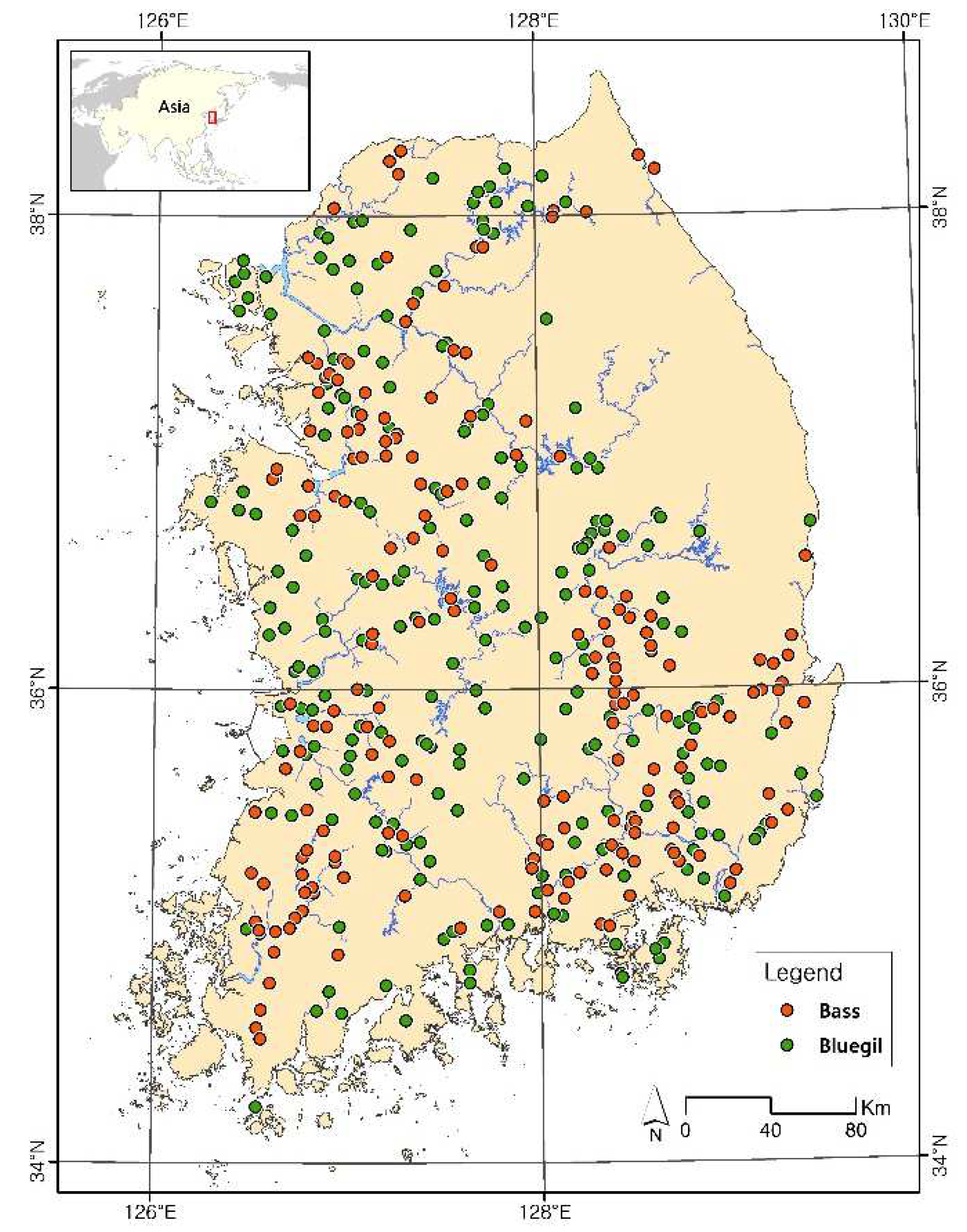
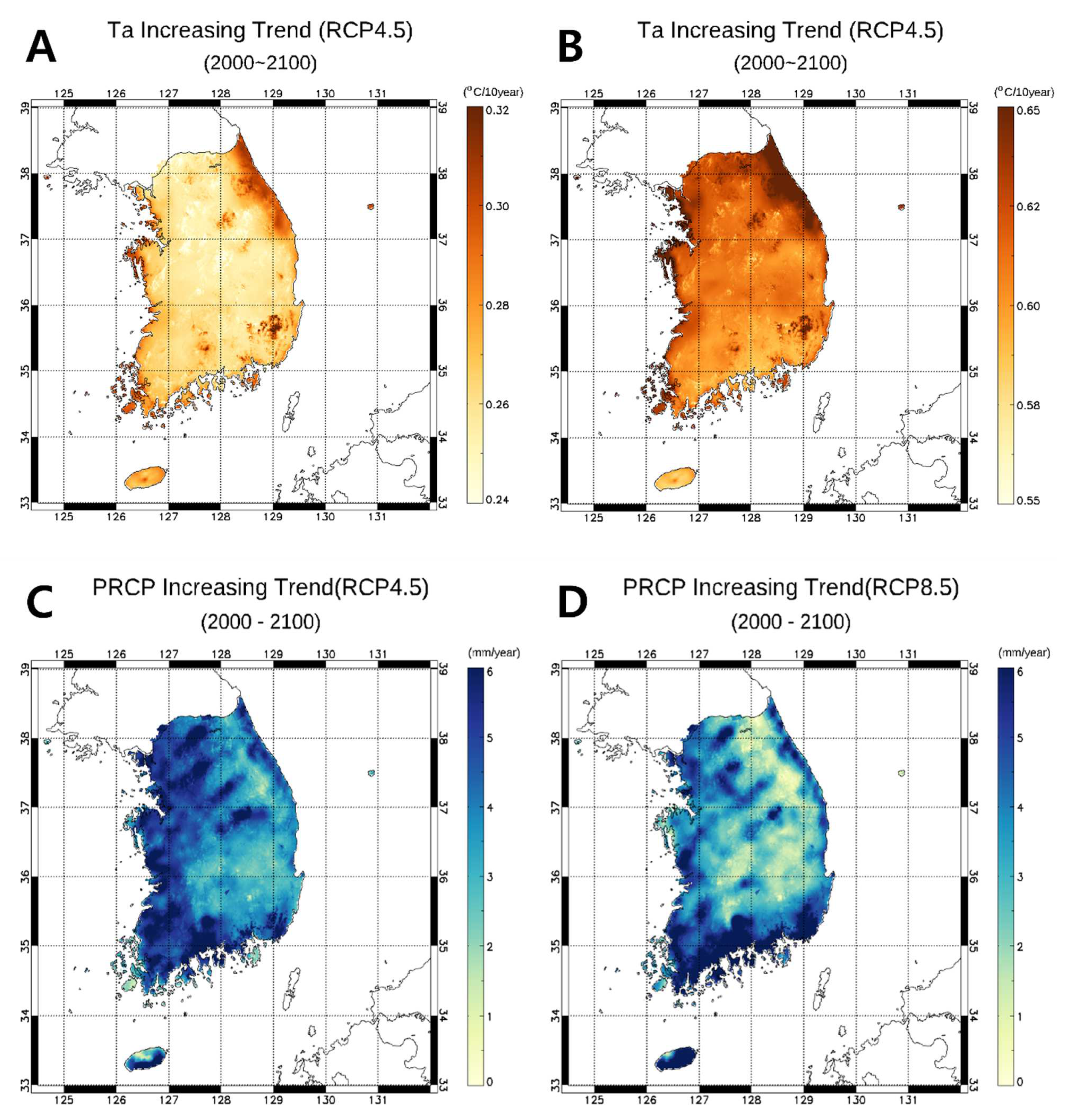
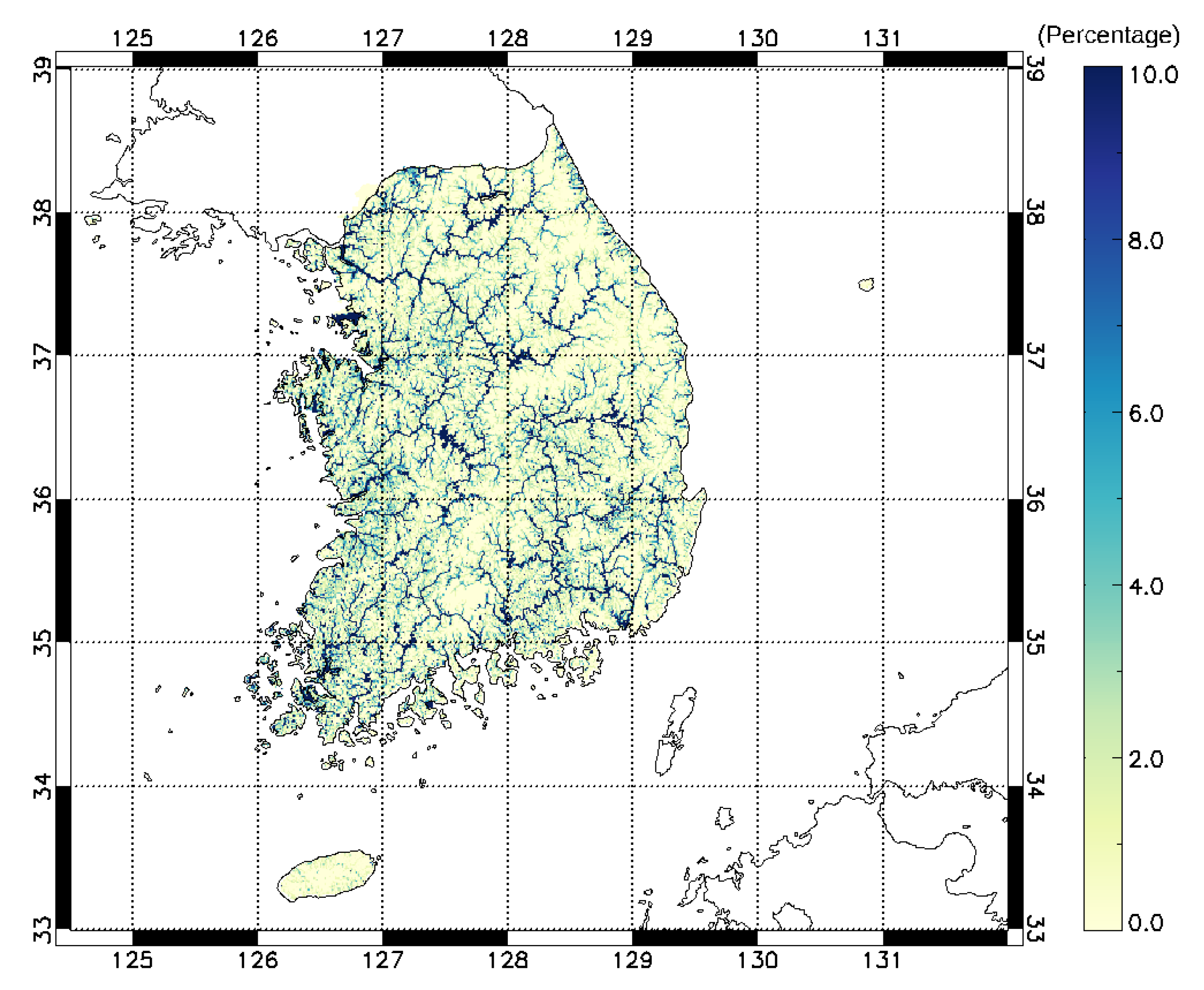
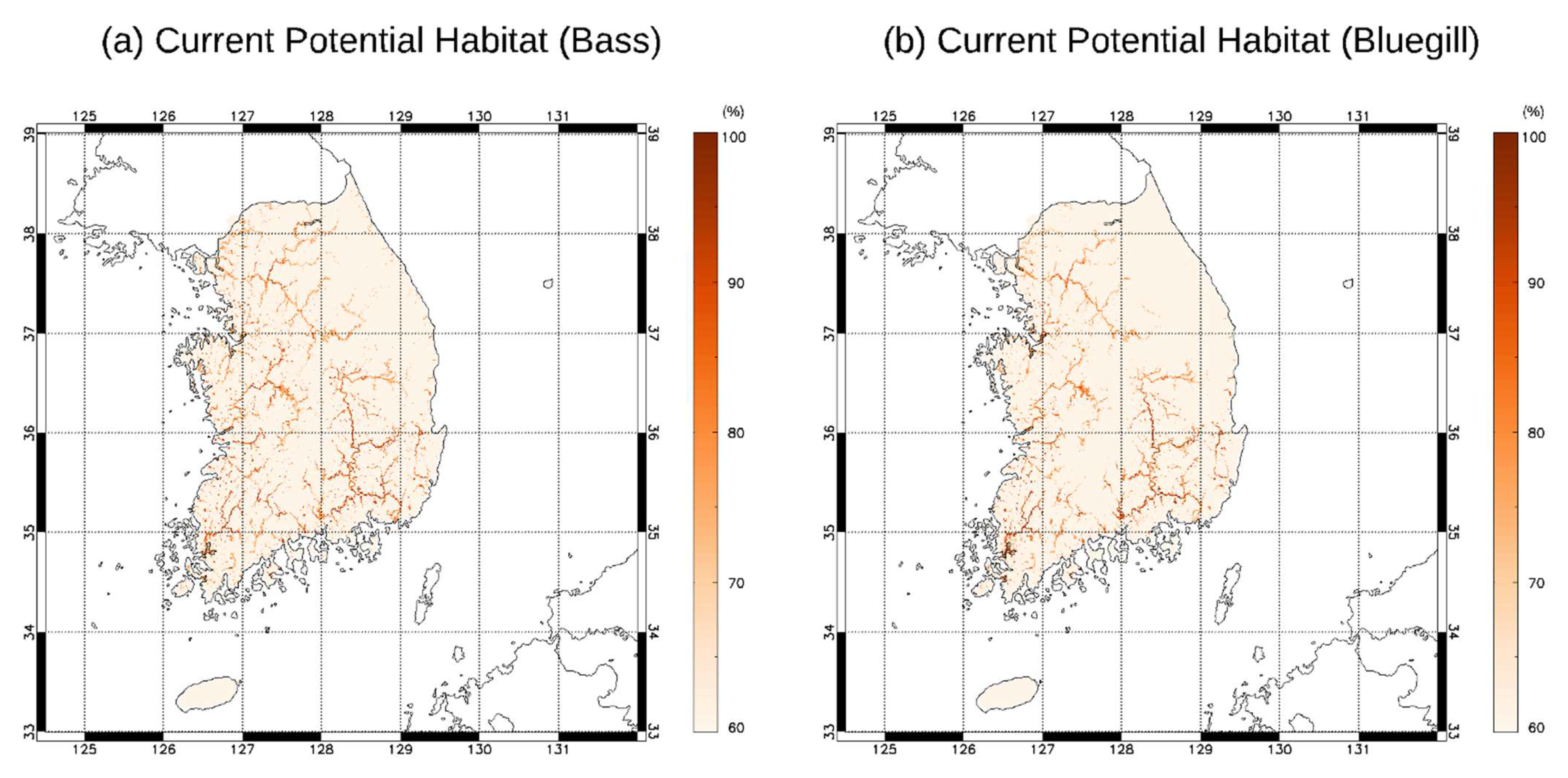
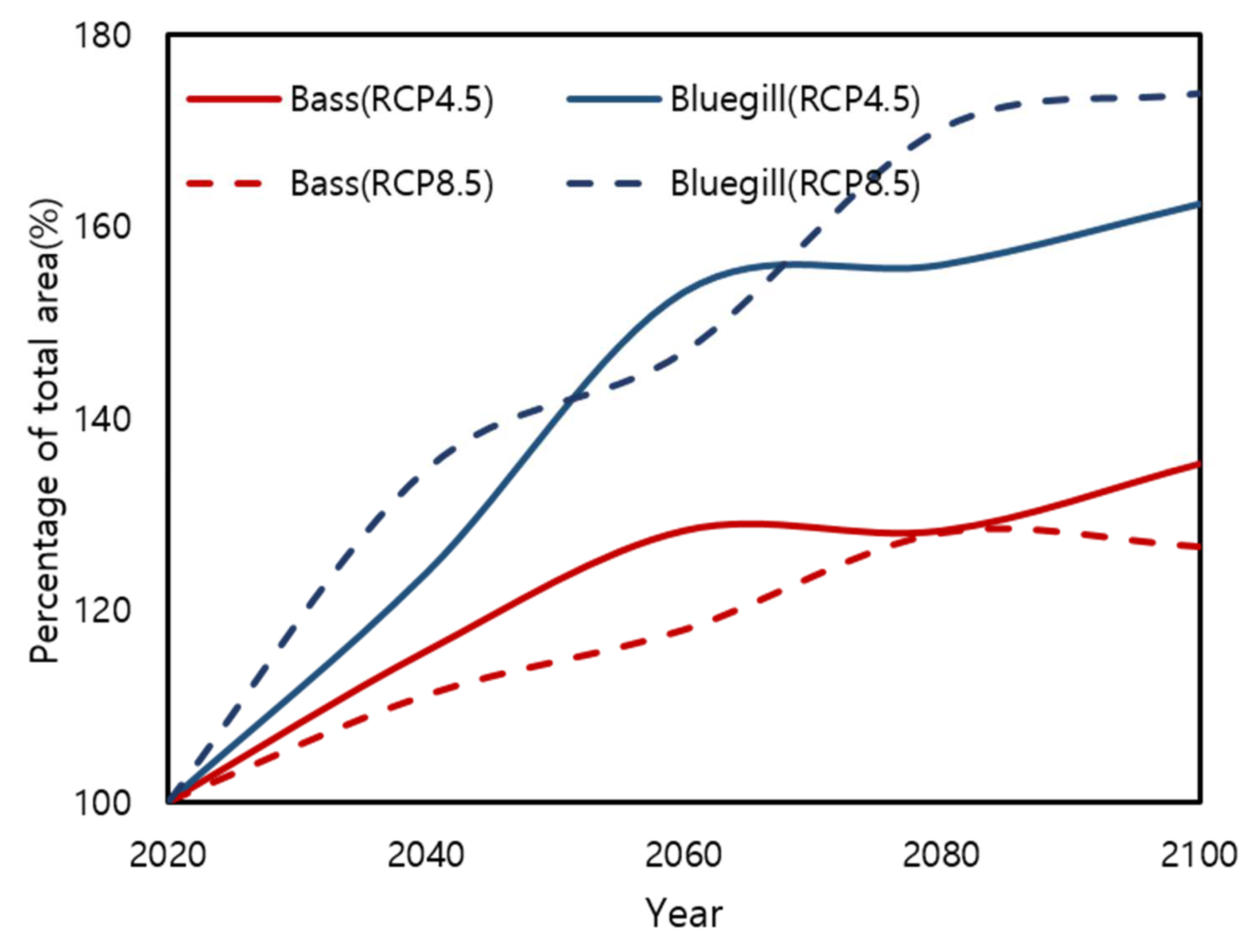
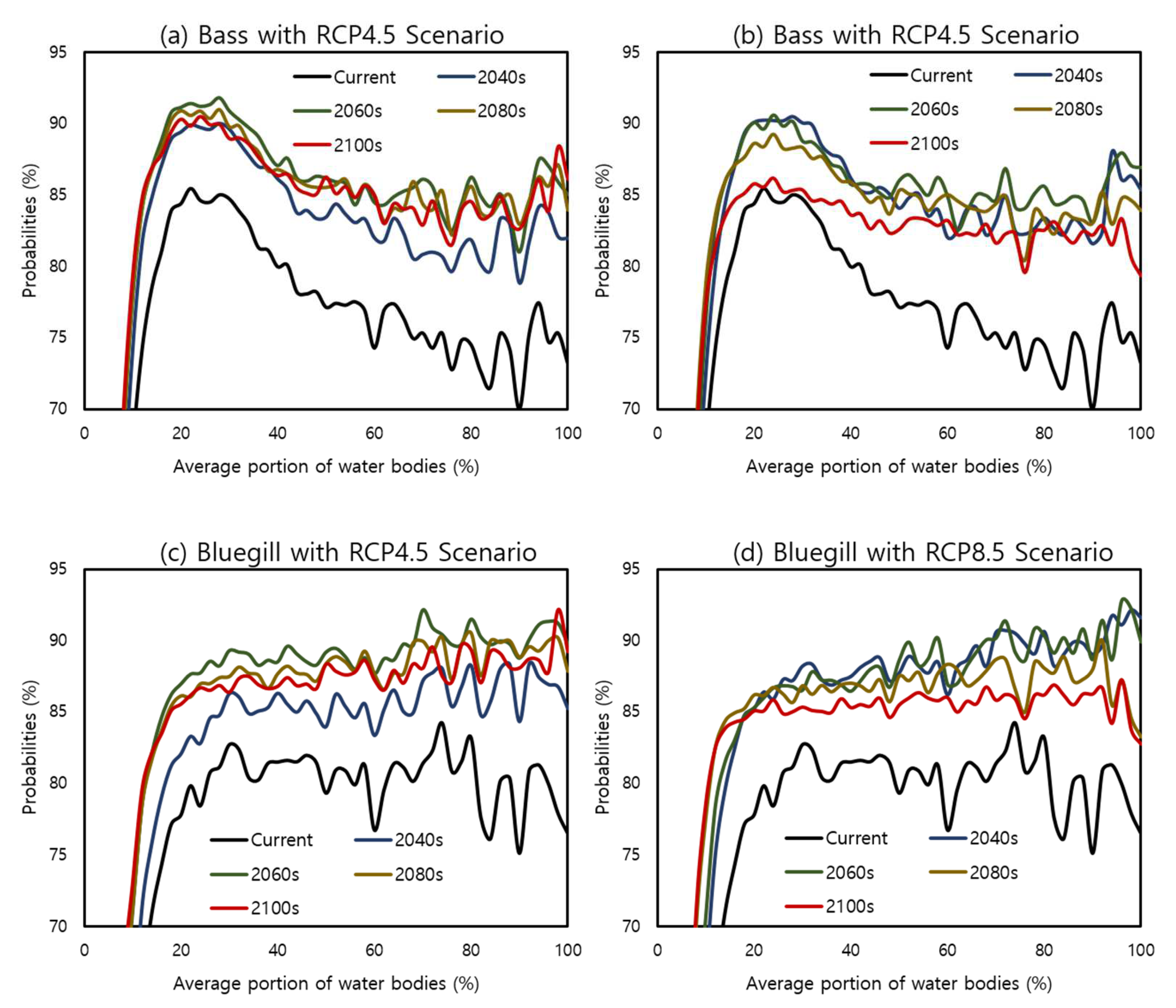
| Name | Description | Name | Description |
|---|---|---|---|
| BIO1 | Annual mean temperature | BIO12 | Annual precipitation |
| BIO2 | Mean diurnal range | BIO13 | Precipitation in the wettest month |
| BIO3 | Isothermality | BIO14 | Precipitation in the driest month |
| Variables | Largemouth Black Bass | Bluegill | ||
|---|---|---|---|---|
| Contribution (%) | Importance (%) | Contribution (%) | Importance (%) | |
| BIO1 | 2.7 | 3.3 | 10.2 | 10.3 |
| BIO2 | 0.7 | 0.7 | 2.3 | 4.4 |
| BIO3 | 0.4 | 1.1 | 0.3 | 2 |
| BIO12 | 0.2 | 0.3 | 0.6 | 1.1 |
| BIO13 | 0.5 | 0.8 | 1.2 | 1.1 |
| BIO14 | 1.5 | 0.8 | 0.9 | 0.7 |
| Slope | 0.4 | 0.6 | 0.7 | 0.3 |
| Water Portion | 93.6 | 92.3 | 83.8 | 80.1 |
Publisher’s Note: MDPI stays neutral with regard to jurisdictional claims in published maps and institutional affiliations. |
© 2022 by the authors. Licensee MDPI, Basel, Switzerland. This article is an open access article distributed under the terms and conditions of the Creative Commons Attribution (CC BY) license (https://creativecommons.org/licenses/by/4.0/).
Share and Cite
Hong, S.; Jang, I.; Kim, D.; Kim, S.; Park, H.S.; Lee, K. Predicting Potential Habitat Changes of Two Invasive Alien Fish Species with Climate Change at a Regional Scale. Sustainability 2022, 14, 6093. https://doi.org/10.3390/su14106093
Hong S, Jang I, Kim D, Kim S, Park HS, Lee K. Predicting Potential Habitat Changes of Two Invasive Alien Fish Species with Climate Change at a Regional Scale. Sustainability. 2022; 14(10):6093. https://doi.org/10.3390/su14106093
Chicago/Turabian StyleHong, Seungbum, Inyoung Jang, Daegeun Kim, Suhwan Kim, Hyun Su Park, and Kyungeun Lee. 2022. "Predicting Potential Habitat Changes of Two Invasive Alien Fish Species with Climate Change at a Regional Scale" Sustainability 14, no. 10: 6093. https://doi.org/10.3390/su14106093






